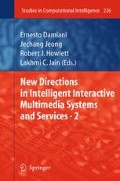Abstract
Human-Computer interaction can be clearly leveraged by using Natural Language systems, specially in interactive environments. In this paper a system which interprets a 3D virtual world in terms of human abstractions like “corridor” or “crossroad” and differences between world items basing on the properties the user refers to, is presented. This interpretation is oriented to human orders understanding, making it possible for the system to be interactively guided by the user. A partial implementation of the algorithm and its results are shown, and discussion about how the system could be empowered for better Natural Language Processing is detailed.
Access this chapter
Tax calculation will be finalised at checkout
Purchases are for personal use only
Preview
Unable to display preview. Download preview PDF.
References
Generating Instructions in Virtual Environments (GIVE) (2009), http://homepages.inf.ed.ac.uk/v1akolle/proj/give/
Clarke, B.L.: A calculus of individuals based on connection. Notre Dame Journal of Formal Logic (1981)
Coenen, F., Beattie, B., Bench-capon, T.J.M., Shave, M.J.R.: An ontology for linear spatial reasoning, pp. 718–727. Springer, Heidelberg (1996)
Coenen, F., Visser, P.: A core ontology for spatial reasoning
Coenen, F., Visser, P.: A generic ontology for spatial reasoning. In: Research and Development in Expert Systems XV, Proc. of ES 1998, pp. 44–57. Springer, Heidelberg (1998)
Cohn, A.G., Bennett, B., Gooday, J., Gotts, N.M.: Representing and reasoning with qualitative spatial relations about regions
Dale, R., Reiter, E.: Computational interpretations of the gricean maxims in the generation of referring expressions. Cognitive Science: A Multidisciplinary Journal 19(2), 233–263 (1995)
Gorniak, P.: A visually grounded natural language interface for reference to spatial scenes. In: Proceedings of the International Conference for Multimodal Interfaces, pp. 219–226. ACM Press, New York (2003)
Grütter, R., Bauer-Messmer, B., Hägeli, M.: Extending an ontology-based search with a formalism for spatial reasoning. In: SAC 2008: Proceedings of the 2008 ACM symposium on Applied computing, pp. 2266–2270. ACM, New York (2008)
Piwek, P.: Meaning and Dialogue Coherence: A Proof-theoretic Investigation. J. of Logic, Lang. and Inf. 16(4), 403–421 (2007)
Reddy, V., Neumeier, K., McFarlane, J., Cothren, J., Thompson, C.W.: Extending a natural language interface with geospatial queries. IEEE Internet Computing 11(6), 82–85 (2007)
Stopp, E., Gapp, K.P., Herzog, G., Laengle, T., Lueth, T.C.: Utilizing spatial relations for natural language access to an autonomous mobile robot. In: Dreschler-Fischer, L., Nebel, B. (eds.) KI 1994. LNCS, vol. 861, pp. 39–50. Springer, Heidelberg (1994)
Author information
Authors and Affiliations
Editor information
Editors and Affiliations
Rights and permissions
Copyright information
© 2009 Springer-Verlag Berlin Heidelberg
About this chapter
Cite this chapter
León, C., de la Puente, S., Dionne, D., Hervás, R., Gervás, P. (2009). Constructing World Abstractions for Natural Language in Virtual 3D Environments. In: Damiani, E., Jeong, J., Howlett, R.J., Jain, L.C. (eds) New Directions in Intelligent Interactive Multimedia Systems and Services - 2. Studies in Computational Intelligence, vol 226. Springer, Berlin, Heidelberg. https://doi.org/10.1007/978-3-642-02937-0_8
Download citation
DOI: https://doi.org/10.1007/978-3-642-02937-0_8
Publisher Name: Springer, Berlin, Heidelberg
Print ISBN: 978-3-642-02936-3
Online ISBN: 978-3-642-02937-0
eBook Packages: EngineeringEngineering (R0)

